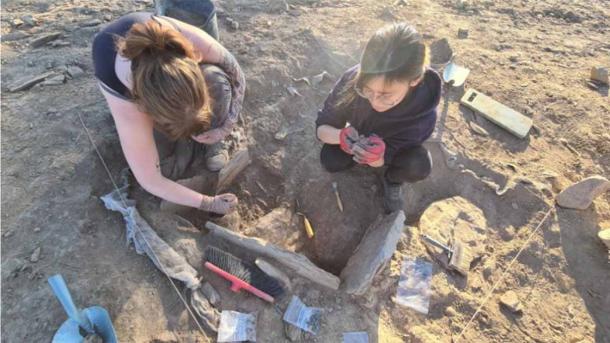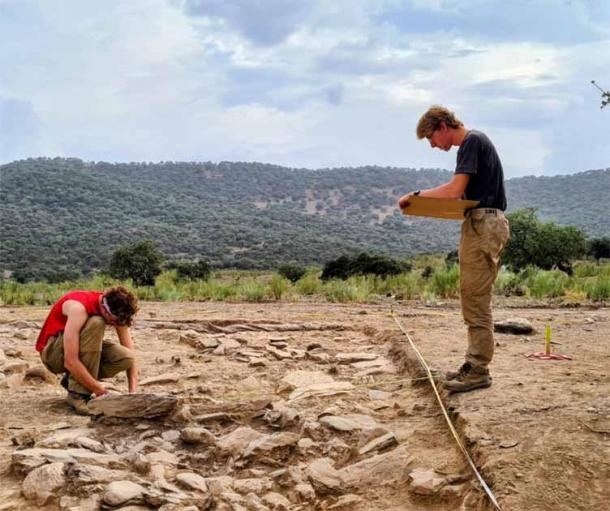
Newly Discovered 3,000-Year-Old Stela in Spain Upends Gender Stereotypes
Archaeologists performing excavations at the 3,000-year-old Las Capellanías funerary complex in southwestern Spain have uncovered a decorated stela (standing stone slab) that features a unique and unprecedented mixture of characteristics that break previous gender stereotypes.
The stone monument depicts a human being wearing a headdress and a necklace and carrying two swords. The person’s face, hands, and feet are portrayed in precise detail, as is the individual’s genitalia, which is male. While the weapons and male genitals are consistent with imagery found on other ancient stelae that depict male warriors, the headdress and necklace are features normally associated with stelae that pay tribute to women. This is a mixture of features never before seen, and it is forcing the experts to reevaluate their beliefs about how prehistoric Iberian societies viewed gender.
In Ancient Spain, Ideas about Gender Were Not So Simple
This is the third stela found at Las Capellanías, which is located in Cañaveral de León, Spain. Cremated human bones were unearthed beside it, leaving no doubt it was placed as a funerary marker or tombstone. It was discovered by archaeologists working under the auspices of the Maritime Encounters project, which is sponsored by the University of Gothenburg in Sweden and includes personnel from the Universities of Seville in Spain and Durham and Southampton in the United Kingdom.

A team from the universities of Seville, Durham, Southampton, and Huelva working on the ancient burial complex Las Capellanías. (University of Durham)
Engraved stone slabs of this type have been recovered in impressive numbers on the Iberian Peninsula. Since the late 19th century approximately 300 stelae have been unearthed in Spain and Portugal, with the oldest dating back to 2,000 BC. The stelae can be anywhere from 1.5 feet (one-half m) to several feet or meters high, and they may be decorated with images of humans or physical objects, or both combined in action scenes.
The consensus opinion of experts is that these stelae were created to commemorate important people, either living or dead. But until now the assumption has been that the men and women depicted on the engraved stelae had filled specific societal roles segregated by gender. So-called ‘warrior’ stelae were believed to always show men, while the ‘headdress’ variety supposedly depicted women exclusively.
“The stela 3 of Cañaveral de León changes all this,” a University of Durham Department of Archaeology press release declared. “It combines traits of ‘headdress’ and ‘warrior’ types, showing that the social roles depicted by these standardized iconographies were more fluid than previously thought. Furthermore, as the new stela also includes male genitalia, it demonstrates that these social roles were not restricted to a specific gender, but could be associated with different genders.”
In other words, if the depiction of the person on the memorial stela seems to feature contradictory elements, it is only because modern archaeologists had jumped to premature conclusions about the rigidity of gender roles in the Bronze Age and Iron cultures that lived in Iberia before and after the year 1,000 BC.
“Las Capellanías is demonstrating that many of our assumptions were wrong,” stated University of Durham archaeologist and excavation co-director Dr. Marta Díaz-Guardamino in an interview with El Pais. “These investigations mark a before and after in the scientific interpretation of these beautiful prehistoric sculptures, since they offer valuable empirical information facilitating the understanding of key aspects in the social organization of the communities that inhabited the Southwest of the peninsular during the second and first millennium B.C.”
While there is no way to tell exactly how these prehistoric cultures viewed gender differences, it is clear their ideas featured a degree of openness or complexity that had not been previously suspected.
- Women Have Been Proposing Marriage to Men on Leap Day for Centuries
- Activist Group Tells Archaeologists Not to Assume Gender of Ancient Skeletons

The discovery site at Cañaveral de León, Spain. (University of Durham)
Monuments to the Dearly Departed at Las Capellanías
Excavations at Las Capellanías have uncovered a variety of funerary monuments, burial mounds, stone cists and cremation pits, revealing significant details about the culture and belief system of prehistoric peoples who lived in this part of ancient Iberia. Finding the stelae within this context unequivocally identifies these standing stone markers as tombstones.
The researchers who’ve been studying the three stelae recovered at the Las Capellanías site believe they acted as territorial markers for the funerary complex as a whole. The newly discovered stela and one found before it were installed at locations that bordered an ancient roadway, one that connected the middle Guadiana and lower Guadalquivir river basins. This suggests the markers may have functioned as de facto road signs that let travelers know they had reached the site of the graveyard.
The making and placement of the stelae may also have had ritual significance to Late Bronze Age and Early Iron Age people, the archaeologists say. But more study of their characteristics and locations will be needed to see if any signs of ritual usage exist.
Groups or collections of these engraved stelae have been found elsewhere in the region, most famously at a site in Hernán Pérez in northern Cáceres, central-west Spain. But most of the stelae found in Iberia over the years were unearthed by farmers ploughing fields or by construction crews building roads, meaning they were not unearthed in the context of actual archaeological work. This made their purpose uncertain.
“The existing theories about their location, function, and social significance have been extremely deficient and were pending verification or demonstration,” University of Seville archaeologist and project co-director Leonardo García Sanjuán told El Pais.
- This 2,800-Year-Old Stele Tells A Bible Story From A Different Point Of View
- Farmer Digs Up Stone Egyptian Stele Saluting Sixth Century BC Pharaoh
Based on the findings at Las Capellanías, the archaeologists speculate that other groupings of stelae may have been associated with funerary complexes as well, even if no actual graves have yet to be found. In the future when prehistoric stelae of this type are unearthed, archaeologists will know that some type of human burial site can likely be found nearby.
“Many of the former questions surrounding the stelae have been answered, thanks to the finds at Las Capellanías,” Garcia Sanjuán stated, speaking for the new consensus that all or most of the engraved stone slabs of Iberia were constructed as monuments to the dearly departed.
Top image: Archaeologists have unearthed an adorned stela at Las Capellanías complex in Cañaveral de León, Spain. Source: University of Durham
By Nathan Falde















